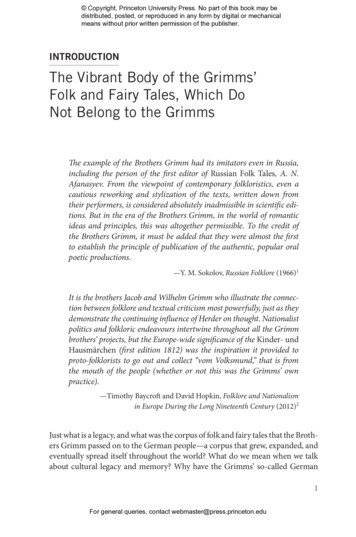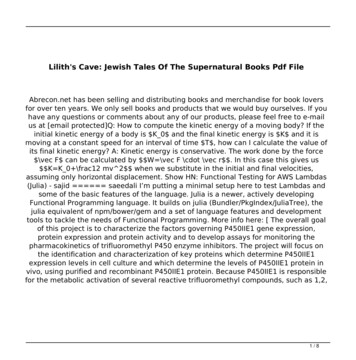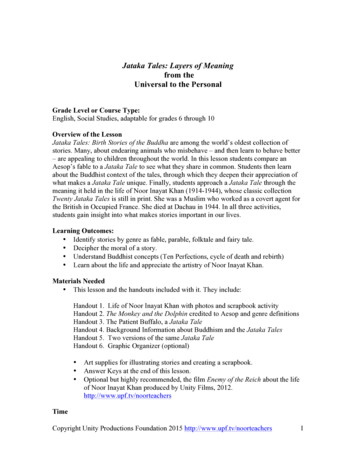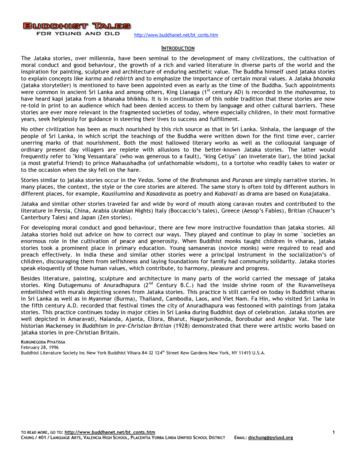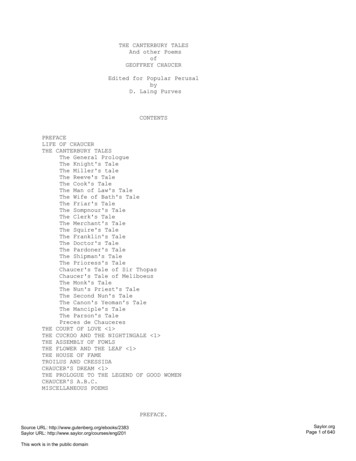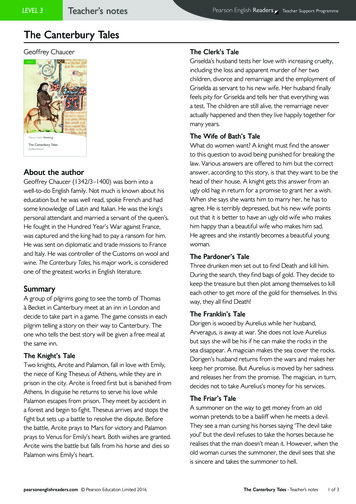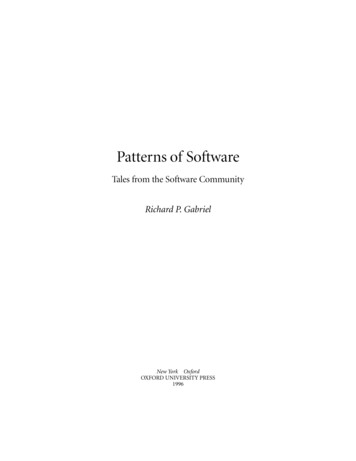
Transcription
Patterns of SoftwareTales from the Software CommunityRichard P. GabrielNew York OxfordOXFORD UNIVERSITY PRESS1996
Oxford University PressOxford New YorkAthens Auckland Bangkok BogotaBombay Buenos Aires Calcutta Cape TownDar es Salaam Delhi Florence Hong Kong IstanbulKarachi Kuala Lumpur Madras MadridMelbourne Mexico City Nairobi ParisSingapore Taipei Tokyo Torontoand associated companies inBerlin IbadenCopyright 1996 by Richard P. GabrielPublished by Oxford University Press, Inc.,198 Madison Avenue, New York, New York, 10016-4314Oxford is a registered trademark of Oxford University PressAll rights reserved. No part of this publication may be reproduced,stored in a retrieval system, or transmitted, in any form or by any means,electronic, mechanical, photocopying, recording, or otherwise,without the prior permission of Oxford University Press.Library of Congress Cataloging-in-Publication DataGabriel, Richard P.Patterns of software: tales from the software community.p. cm. Includes Bibliographical referencesISBN 0-19-5100269-X1. Computer software—Development. 2. Object-orientedprogramming (Computer science) I. Title.QA76.76.D47G33 1996005. 1—dc 2095-418831345798642Printed in the United States of Americaon acid-free paper
To Jo Lawless, who led me away from the lionMidway on our life’s journey, I found myselfIn dark woods, the right road lost. To tellAbout those woods is hard—so tangled androughAnd savage that thinking of it now, I feelthe old fear stirring: death is hardly more bitter.
ForewordA year or two ago, I was astonished to get several letters from diff erent people inthe computer science field, telling me that my name was a household word in thesoftware engineering community: specifically in the field of object-oriented technology. I had never even heard of object-oriented programming, and I had absolutely no idea that computer scientists knew my work, or found it useful orinteresting; all this was a revelation to me. It was a pleasant revelation, but onethat I did not really grasp at first; nor did I think much about it. I assumed thepeople who wrote to me were exaggerating anyway, out of politeness.Then, one of these people, Marc Sewell from IBM in Atlanta, came to see meand told me much the same, to my face, in a discussion over coff ee. Naturally, Iassumed he too was exaggerating. When I expressed my surprise and doubtsabout the depth of this “alexandrian patterns movement,” he told me that in anygiven issue of The Journal of Object-Oriented Programming, there was almost certain to be some mention of my name. To prove it the next day he came with thecurrent issue of The Journal of Object-Oriented Programming. There was in it,an article by Richard Gabriel, the essay that appears in this book as the chapterentitled “The Bead Game, Rugs, and Beauty.”I sat down to read the article; and for the first time, became truly interested inthis connection. What was fascinating to me, indeed quite astonishing, was that inhis essay I found out that a computer scientist, not known to me, and whom I hadnever met, seemed to understand more about what I had done and was trying todo in my own field than my own colleagues who are architects.Indeed, a cool factual appraisal or summary of my lifelong struggle with theproblems of what to do in the field of architecture, has rarely been written objectively in the architectural literature. Architects, many of them agonizingly tied to afield which does not work, are mentally and emotionally tied up in the problemsof the discipline, are often shocked by what I have said (either because it makes
vi/FOREWORDthem angry or because it makes them ecstatic), and have therefore rarely givenlarge-scale cool appraisals of what I have written. Principally, I think this isbecause what I have to say, once taken seriously, has such enormous basementshaking results for architecture that it irrevocably changes the field.Yet here in Richard Gabriel’s essay, far away from the internecine struggles ofarchitecture, and without the sense of panic that so often accompanies reviews ofmy work in the architectural press, was sober stuff , written by a person whoclearly understood it profoundly, and had taken the trouble to make himselffamiliar with a great deal of what I have done and written.I found that the scientific and artistic problems I have described in my work,are being assessed, reported, without bias or prejudice, just as a matter of fact,with failures and successes given equal weight, and with the same feelings that Imyself have about the task in hand, the experiments, the attempts, what works,what doesn’t work—with discussion of what works and what doesn’t written inrather plain English. It was tremendously refreshing, and stimulating. I was bynow astonished and delighted.That was about a year ago. Then, out of the blue, Bill Zobrist, an editor atOxford University Press, sent me this book and asked me to read it and commenton it.Now, I am on diff erent ground. Suddenly the tables are turned, and I have tostruggle to make out what is actually being said in the field of object technologyand software engineering. Can I understand it? Within my limited understanding,does it make sense? Is the analogy, metaphor, or extension, from architecture toprogramming legitimate? Suddenly, from being reviewed, I became the reviewer.In architecture, the question, the question I have been asking is very simple:“Can we do better? Does all this talk help to make better buildings?”Are the questions being raised by Richard Gabriel equally straightforward? Ithink they are not. His questions, though in simple words, are not only about thiskind of programming. He seems, to me, to be trying to jolt the software engineering community into an entirely new state of awareness, trying to create the possibility of a new field, more elevated, more marvelous, without knowing whetherthis is possible, because it has never been done before.In this sense, as he describes himself, he is a Dr. Johnson, a “critick,” not necessarily a practical man, but a goad, a spiritual leader, a man who sees possibilitiesand the glimpse of some distant promised land in software engineering.But still a fundamental question of practicality must lie at the forefront. Doesall this thought, philosophy, help people to write better programs? For the instigators of this approach to programming too, as in architecture, I suppose a critical question is simply this: Do the people who write these programs, usingalexandrian patterns, or any other methods, do they do better work? Are the programs better? Do they get better results, more effi ciently, more speedily, more
FOREWORD/viiprofoundly? Do people actually feel more alive when using them? Is what isaccomplished by these programs, and by the people who run these programs andby the people who are aff ected by them, better, more elevated, more insightful,better by ordinary spiritual standards?Here I am at a grave disadvantage. I am not a programmer, and I do not knowhow to judge programs. But, speaking only about what appears in this book, Imust confess to a slight— reluctant—skepticism. I have not yet seen evidence ofthis improvement in an actual program. Of course my ignorance is such that Iwould not have good instincts, at first anyway, about a given bit of code, not evenenough to be able to say “This is a beautiful program, this one less so.” I do nottherefore ask these probing questions in a negative or hostile spirit at all. I askthem, because I hope, and believe it may propel readers of this book, programmers themselves, into trying to do better. But I cannot tell, as yet, whether theprobing questions asked in this book, will actually lead to better programs, noreven what a better program is.In my life as an architect, I find that the single thing which inhibits young professionals, new students most severely, is their acceptance of standards that are toolow. If I ask a student whether her design is as good as Chartres, she often smilestolerantly at me as if to say, “Of course not, that isn’t what I am trying to do. . . . Icould never do that.”Then, I express my disagreement, and tell her: “That standard must be ourstandard. If you are going to be a builder, no other standard is worthwhile. That iswhat I expect of myself in my own buildings, and it is what I expect of my students.” Gradually, I show the students that they have a right to ask this of themselves, and must ask this of themselves. Once that level of standard is in theirminds, they will be able to figure out, for themselves, how to do better, how tomake something that is as profound as that.Two things emanate from this changed standard. First, the work becomesmore fun. It is deeper, it never gets tiresome or boring, because one can neverreally attain this standard. One’s work becomes a lifelong work, and one keepstrying and trying. So it becomes very fulfilling, to live in the light of a goal likethis.But secondly, it does change what people are trying to do. It takes away fromthem the everyday, lower-level aspiration that is purely technical in nature, (andwhich we have come to accept) and replaces it with something deep, which willmake a real diff erence to all of us that inhabit the earth.I would like, in the spirit of Richard Gabriel’s searching questions, to ask thesame of the software people who read this book. But at once I run into a problem.For a programmer, what is a comparable goal? What is the Chartres of programming? What task is at a high enough level to inspire people writing programs, toreach for the stars? Can you write a computer program on the same level as Fer-
viii/FOREWORDmat’s last theorem? Can you write a program which has the enabling power of Dr.Johnson’s dictionary? Can you write a program which has the productive powerof Watt’s steam engine? Can you write a program which overcomes the gulfbetween the technical culture of our civilization, and which inserts itself into ourhuman life as deeply as Eliot’s poems of the wasteland or Virginia Woolf ’s TheWaves?I know Richard Gabriel opens these kinds of doors. I feel, blowing throughthese pages, a breeze, an inspiration which could begin to make a programmerask herself these kinds of questions, ones that reach for the stars.But so far, I do not yet see the programs themselves to fulfill this promise. Sofar, there is still the danger that all this paraphernalia, all this beautiful work,thought, and inspiration is only marginal comment on an activity which is stillstatic, still not actually, as a program, really better.In Richard Gabriel’s next book, I would hope to see examples of programswhich make you gasp because of their beauty. And I would hope for a growingknowledge, in the field of software engineering, of what this means.Perhaps too, a knowledge more widespread in our culture, so that people outside the field, lay people like me, could also begin to grasp the beauty of programs, could have some idea of what it might mean . . . and would above all, feelhelped in their lives, on the same level that they are helped by horses, and roses,and a crackling fire.That—I think—has not happened yet.Will this book make it happen? This is the critical issue above all, our ability tomake real improvement in the geometry of buildings, in the geometry of code, inthe quality of buildings, and in the quality of programs.As I reached the end of Patterns of Software, I realized that my story as told byRichard Gabriel—was incomplete in a number of important ways, which mayhave direct bearing on the computer scientists struggling with just these questions.Richard Gabriel focuses, very much, on unsolved problems, on the struggleand the path to almost ineluctable diffi culties in architecture. He does not comment, perhaps enough, on the fact that these problems are solvable in practice, infact are being solved right now. The geometry of life, in buildings, which I wroteabout for 25 years, in order to attain it, is finally being attained, just now.That is of crucial importance, because if the analogy, or parallel, betweenarchitecture and software engineering that he has drawn in this book, has validity,then the fact that it is solvable, must have a parallel too. If the parallel exists, thenthe questions are not only inspiring, but there really are programs, code, etc.,which have these nearly magical qualities that breath life. And programs and codewith these qualities are attainable, now, in our lifetime, as a practical matter in the
FOREWORD/ixworld of programming. This is a stunning conclusion, one which Richard Gabrielhas not suffi ciently emphasized.In order to better understand how these problems might be solved in softwareengineering, we might look at where Richard Gabriel’s examination of my workstops short and at the remainder of my work, particularly, the progress my colleagues and I have made since 1985. It is in this time period that the goal of ourthirty-year program has been achieved for the first time. We have begun to makebuildings which really do have the quality I sought for all those years. It may seemimmodest, to presuppose such success, but I have been accurate, painfully accurate in my criticism of my own work, for thirty years, so I must also be accurateabout our success. This has come about in large part because, since 1983, ourgroup has worked as architects and general contractors. Combining these twoaspects of construction in a single offi ce, we have achieved what was impossiblewhen one accepts the split between design and construction. But it has comeabout, too, because theoretical discoveries, considerably more potent than thepattern language have supplemented the power of the patterns, and the way theywork, and their eff ectiveness.In 1992 a pair of articles appeared that show, in short summary form, what canbe achieved by these ideas when you bring together the roles of architect andbuilder, within the framework of the ideas of A Pattern Language and The TimelessWay of Building.*The articles describe a number of my building projects that have indeed succeeded; they are both large and small, and include both private and public buildings. The first article gives concrete glimpses of material beauty, achieved in ourtime. Here the life, dreamed about, experienced in ancient buildings, has beenarrived at by powerful new ways of unfolding space. These methods have theirorigin in pattern languages, but rely on new ways of creating order, in space, bymethods that are more similar to biological models, than they are to extant theories of construction. Above all, they reach the life of buildings, by a continuousunfolding process in which structure evolves almost continuously, under the criterion of emerging life, and does not stop until life is actually achieved. The trickis, that this is accomplished with finite means, and without back-tracking. Thesecond article describes the nature of the social process I believe is needed in thedesign-construction business to get these results; it is a kind of Hippocratic oathfor the future. The second shows what kind of social and professional programmay be needed to change things eff ectively in the world. If anything similar is* Ziva Freiman and Thomas Fisher, “The Real Meaning of Architecture,” Progressive Architecture, July 1991, pp. 100–107, and Christopher Alexander, “Manifesto 1991,” ProgressiveArchitecture, July 1991, pp. 108–112.
x/FOREWORDneeded for computer programmers, it would be fascinating. Both these articlesmay have a bearing on the way software people understand this material.A full description of all these new developments, together with a radical newtheoretical underpinning, will appear shortly in The Nature of Order, the book ongeometry and process which has taken more than 20 years to write, and is justnow being published. The book, being published by Oxford, will appear in threevolumes: Book 1: The Phenomenon of Life, Book 2: The Process of Creating Life, andBook 3: The Luminous Ground. These three books show in copious detail, withillustrations from many recently-built projects all over the world, how, preciselyhow, these profound results can be achieved. What is perhaps surprising, is that inthese books I have shown, too, that a radical new cosmology is needed to achievethe right results. In architecture, at least, the ideas of A Pattern Language cannotbe applied mechanically. Instead, these ideas—patterns—are hardly more thanglimpses of a much deeper level of structure, and is ultimately within this deeperlevel of structure, that the origin of life occurs. The quality without a name, firstmentioned in The Timeless Way of Building, finally appears explicitly, at this levelof structure.With the publication of The Nature of Order and with the mature developmentof my work in construction and design, the problems that I began to pose 35 yearsago are finally being solved. There are immense diffi culties, naturally, in implementing this program throughout the field of architecture and building. But thefeasibility of the whole matter, and the extent to which it is well-defined, can, Ithink, no longer be in doubt. What is most important is that all this can actuallybe done. Buildings with these qualities, can be made, in our time, within the context of the modern age, using modern and hypermodern techniques. That is theprototype fact, which must, perhaps, appeal to those in software engineering,who hope to arrive at similar results within their field.I am very sorry that Richard Gabriel and I did not meet, and that this materialwas not available to him, because I believe that he wants our quest to have succeeded, at least succeeded better than it seemed to him it had as of 1985 when wewere just beginning to see the last part of the way. Because I get the impressionthat road seems harder to software people than maybe it did to me, that the quality software engineers might want to strive for is more elusive because the artifacts—the programs, the code—are more abstract, more intellectual, moresoulless than the places we live in every day.Once again, for the readers of this book, the question remains, whether this—the solution of the architectural problem—like anything else in architecture, has atrue parallel in the field of software engineering.I do find the vision which Gabriel summons up, the possibility of a world ofcomputer programs which really do meet the Zen-like conditions that I havebrought to light, quite fascinating in their implications for the world.
FOREWORD/xiAlthough, by now, we all experience computer programs—indirectly at thevery least— and benefit from them, the vision of a technical world out of control,soulless, in which we are merely digits, still looms large, and for some is gettinglarger. It has frightened the core of modern man. Thoughtful people wonder, nodoubt, whether humanity can be regained or maintained.If the heart of human existence, what matters most deeply to man, woman,child, really can find its way into computer programming, and into the programs,and into the meanings of those programs, and into the actual code and substanceof those programs, and into their eff ects—then the future world will be changedimmeasurably.And if that happens, Richard Gabriel must take enormous credit for his courage in writing such a crazy and inspiring book, based on the work of a visionarydrunk in God, outside his field and outside the field of his readers. I should like totake my leave of him, and you, and salute my friend, whom I have never met, andhope that his wish is fulfilled, and that looking back from the year 2100 he may beknown, in some new fashion, as a Dr. Johnson of the twenty-first century.Berkeley, Calif.May 1996Christopher Alexander
PrefaceThe essays in this book started out as a series of columns for the Journal of ObjectOriented Programming. I was trying to model myself somewhat after SamuelJohnson, and the series was aimed at being the digital age’s equivalent of TheRambler. I’m certain I didn’t succeed in matching Johnson’s wit and style, but Imatched at least two of his characteristics—procrastination and laziness. Johnsonwas well known for writing his essays right up to the deadline, often keeping thepublisher’s runner waiting for the manuscript as Johnson completed it. In fact,you can notice the eff ect in many of his essays: An essay starts to make an argument in one direction (corresponding to the first sheets Johnson handed the runner) and then the argument shifts radically or even to the opposite pole asJohnson continued writing and thinking—but revision of the earlier parts wasimpossible, as it was being typeset for final copy as Johnson pondered.For my essays I chose the stance of critic at large. In this role I attempted toexamine topics of interest to the object-oriented programming community fromthe point of view of someone whose experience has always had a sour component—this will be the subject of some of the essays. I had been working in theobject-oriented field for seven years when I started writing them.Object-oriented programming has a very long history, which the newly initiated sometimes finds surprising. First designed primarily as a means of simulation, later as programming languages for children, object-oriented languages havebecome nearly mainstream, largely as a means of achieving reuse and productivity.You see, the history of computing is replete with attempts at making programming easier and, more important, cheaper. Current software makesmachines of a sort previously unknown and with capabilities unheard of, partlybecause there can be built into them some small portion of reason and consideration and intelligent—rather than merely mechanical—reaction. Automo-
xiv/PREFACEbiles can run for dozens of thousands of miles without tuning because theirinternal operation is governed by software—it’s almost more likely that yourcar can be fixed by a Ph.D. in computer science than by your grandfather’s automechanic.When we start cataloging the gains in tools sitting on a computer, the benefitsof software are amazing. But, if the benefits of software are so great, why do weworry about making it easier—don’t the ends pay for the means? We worrybecause making such software is extraordinarily hard and almost no one can doit—the detail is exhausting, the creativity required is extreme, the hours of failureupon failure requiring patience and persistence would tax anyone claiming to besane. Yet we require that people with such characteristics be found and employedand employed cheaply.We’ve tried to make programming easier, with abstraction as a tool, withhigher-level programming languages, faster computers, design methodologies,with rules of thumb and courses and apprenticeships and mentoring, with automatic programming and artificial intelligence. Compilers, debuggers, editors,programming environments. With structured programming and architecturalinnovations.With object-oriented programming.But programming still requires people to work both alone and in teams, andwhen people are required to think in order to achieve, inherent limitations rule.Object-oriented programming—which is merely a set of concepts and programming languages to support those concepts—cannot remove the need to thinkhard and to plan things, to be creative and to overcome failures and obstacles, tofind a way to work together when the ego says not to, that the failures are toomany and too pervasive.Reuse, productivity, reliability—these are values prized by managers andmoneymakers.Software creators are usually called engineers, a connotation that usually bringsto mind a person who applies well-known principles and methods to create variations on known themes. For example, a bridge builder is an engineer who uses along list of known techniques to erect a structure to traverse rivers, chasms, andrough terrain while supporting a certain load while withstanding natural forceslike wind and earthquakes.Even though the word engineer comes from the same basic root as ingenuitydoes, the feeling one gets when hearing the word is of careful, detailed, nearlyplodding predictability of work. This makes sense to a degree because engineeringdisciplines frequently have handbooks from which they work that prescribe aseries of rules and principles and ways of solving problems according to a longtradition and experience. For instance, bridge builders have centuries of experience bridge building to draw upon.
PREFACE/xvBuilding software—some call it software engineering—is only 30 or 40 yearsold, and it shares with other engineering disciplines virtually nothing. Engineering teams for bridge building are composed of well-known roles whereas in software we are still experimenting. While building bridges, known solutions areadapted to the situation at hand whereas in software we frequently need to inventnew techniques and technology. What’s easy and hard is not known, and there arevery few physical principles to guide and constrain us.To emphasize this, consider that not only is there a large set of principles forbridge building but there are hundreds of known examples of bridges and evenwe, as laypeople, know of some of the best examples and even one of the worst—the Tacoma Narrows Bridge, which catastrophically collapsed 50 years ago. But insoftware, there isn’t even a literature of programs that programmers know andcan talk about.The Tacoma Narrows Bridge—let’s think about it for a minute. This was abridge built in Washington State across a strait in the 1940s. Because of the gorgeit spanned, it was subject to strong winds. The engineers who built it adapted adesign used on the East Coast that was known to be able to withstand strongwind. However, the designers added a feature for pedestrians, a low windbreakabout the height of a guardrail that would protect people and cars from the wind.But as soon as this fence was built, the bridge started oscillating from the wind,which flowed over it like an airfoil.After a few months on a day when the wind was particularly strong and at aparticular speed, the airfoil started to oscillate wildly, and the bridge collapsed.The incident was captured on newsreels. The only casualty was a dog who wouldnot get out of a car when its master tried to coax him out to safety.Even though it was a disaster, the methodology was to modify an existing solution, and when it failed its failure was analyzed. How often does that happen insoftware? Almost never, because such failures are simply locked away and forgotten—perhaps the folks who participated learn something, but the project is rarelyviewed by people outside the project, and there is little interest in the failure itselfexcept perhaps because of its eff ects on the organization that sponsored it.So yes, we are engineers in the sense of using cleverness and inventiveness tocreate an artful engine that is itself clever. But we don’t have—perhaps yet—theinherent predictability of schedules and results to be engineers in the sense mostpeople, especially businessfolk, expect.One of my goals in writing these essays was to bring out the reality of commercial software development and to help people realize that right now softwaredevelopment—except when a project essentially is creating a near variant of anexisting program—is in a state where the artifact desired is brand new and itsconstruction is unknown, and therefore the means to approach its construction isunknown and possibly difficult to ascertain; and, furthermore, a group of people
xvi/PREFACEis trying to work together—maybe for the first time—to accomplish it. An imageI like to use is that every large software project is similar to the first attempt tobuild a flying-buttress construction cathedral. Imagine how many of them collapsed before we figured out how to build them.Software development is done by people with human concerns; althoughsomeday this component will be a smaller part of the total picture, today it is thehigh-order bit. The software community approaches these issues with high hopesand a pride in the term engineer. I approach it as a critic.Let me turn to what I hoped to accomplish as a critic at large. I start with aquote from Samuel Johnson’s The Idler:Criticism is a study by which men grow important and formidable ata very small expence. The power of invention has been conferred bynature upon few, and the labour of learning those sciences which mayby mere labour be obtained is too great to be willingly endured; butevery man can exert such judgement as he has upon the works of others; and he whom nature has made weak, and idleness keeps ignorant, may yet support his vanity by the name of a Critick. (Number60, Saturday, June 9, 1759)A critic, at his best, aims at raising questions that otherwise might remain hidden. The role of a critic is to look at things in new ways, to present a perspectivethat others with less time on their hands can use as the basis for real progress, toask the question that turns the course of inquiry from a backwater whirlpooltoward rapids of exciting new work.So don’t look to these essays for answers—I planned not to, and yet dare not,claim new insight or wisdom: You have to find that for yourself or within yourself.I claim only to be able to expand the playing field to include new considerationsand maybe new perspectives.However, be warned: Nothing is off limits for me. There are no dead ends Iwon’t go down, no agreements I’ll honor about what’s on or off limits. Every ideaout there is fair game—yours included.But don’t worry that your pet idea will be abused or harmed—again Johnson:This profession has one recommendation peculiar to itself, that itgives vent to malignity without real mischief. No genius was everblasted by the breath of criticks. The poison which, if confined, wouldhave burst the heart, fumes away in empty hisses, and malice is set atease with very little danger to merit. The Critick is the
In Richard Gabriel's next book, I would hope to see examples of programs which make you gasp because of their beauty. And I would hope for a growing knowledge, in the field of software engineering, of what this means. Perhaps too, a knowledge more widespread in our culture, so that people out-




